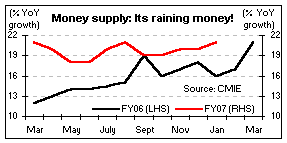|
|
| Help | |
| You are here: Rediff Home » India » Business » Budget 2007 » Report |
|
| |||||||||||||||||||||||
|
| |||||||||||||||||||||||
Last Updated: February 27, 2007 17:15 IST
The scurry of activities and developments in the Indian banking sector in FY07 were manifested in the government's and the RBI's efforts of reconciling the twin objectives of facilitating economic growth and containing inflation. Both the governing bodies had their share of surprises in this fiscal.
While the economic (GDP) growth of 9.2% in 1HFY07 was way beyond the targeted 7.0% to 7.5% rate, inflation (measured in terms of wholesale price index, WPI) remained stubborn despite lower crude prices and touched a high of 6.7% in February 2007 (RBI's target is 5.0% to 5.5%). The monetary policies, therefore, were carefully calibrated to tame inflation without hurting the gathering growth momentum.
Flush with liquidity
Money supply (measured in terms of broad money, M3) grew by a whopping 21% YoY until January 2007 on the back of 17% YoY growth during the corresponding period of FY06. This was primarily funded by bank credit to the commercial sector (grew 27% YoY) and accretion to the net foreign exchange assets of the banking sector (also grew 27% YoY).
It must be noted that with money supply growing faster that the nominal GDP in recent years, the velocity of money (ratio of nominal GDP to average M3 stock during the year) has declined from 1.62 in FY02 to 1.47 in FY05 and 1.45 in FY06.
 |  |
RBI: Walking the tight rope
The RBI's monetary policy stance was attuned to blend a prohibitive interest rate environment with consistent growth momentum and price stability. The focus was on credit quality and supporting the export and investment demand in the economy. The RBI's deliberations were aimed at maintaining macroeconomic stability in general and responding swiftly to evolving global developments in particular.
Economic Survey 2006-07: Complete Coverage
The quarterly monetary reviews also spelt out the following three issues:
demand pressures appearing to have intensified, reflected in rising inflation, high credit growth, elevated asset prices, strains on capacity utilisation and widening of trade deficit;
increased supply-side pressures evident from rising prices of primary articles; and
the need of the monetary policies to contend with lagged response of productive capacity and infrastructure to the ongoing expansion in investment.
Rates on the spring board...
With buoyancy in credit growth and corresponding shortfall in deposit accretion, the credit to deposit ratio in the banking sector shot up from 65% in January 2006 to 74% in January 2007. To bridge the widening gap between incremental credit disbursal and deposit accretion, banks chose to offload their excess SLR portfolio (above 25%).
The monetary tightening initiatives by way of hike in the CRR (cash reserve ratio), repo and reverse repo rates also culminated in banks across the board raising their benchmark prime lending rates (BPLR) to counter the hike in funding costs and sustain net interest margins (NIMs).
The RBI has attributed the high demand for non-food credit to the higher than expected economic (IIP) growth in the manufacturing sector. Having said that, the incremental disbursements to commercial real estate (grew 95% YoY in 1HFY07), home loans (grew 38% YoY) and capital market related activities (grew 39% YoY) were higher than credit to industry (grew 32% YoY) and credit to agriculture (grew 39% YoY).
| (%, per annum) | Jan-05 | Jan-06 | Jan-07 |
| Bank rate | 6.00 | 6.00 | 6.00 |
| Cash Reserve Ratio (CRR)* | 5.00 | 5.00 | 5.50 |
| Statutory Liquidity Ratio (SLR) | 25.00 | 25.00 | 25.00 |
| Benchmark PLR | |||
| PSU Banks | 10.25-11.25 | 10.25-11.25 | 11.50-12.25 |
| Private sector banks | 11.00-14.00 | 11.00-13.50 | 11.75-15.50 |
| Weighted call money rates | 4.72 | 7.40 | 7.76 |
| Comm.Papers by companies | 5.20-7.25 | 6.20-7.75 | 7.74-10.00 |
| 10 year GSec yield | 6.67 | 7.20 | 7.73 |
| Deposit rate (> I year) | 5.25-6.25 | 5.50-6.50 | 7.25-8.50 |
| Repo rate | 6.00 | 6.50 | 7.50 |
| Reverse repo rate | 4.75 | 5.50 | 6.00 |
* Subsequently raised to 6% in February 2007.
Outlook
The economic survey has based its positive outlook on economic growth momentum and the analogous requirement for higher credit disbursals on the underlying facts that the quality of credit continues to remain healthy and that credit as a proportion of GDP is low in India by international standards. Hence, credit will continue to outpace GDP in terms of growth in the years to come.
At the same time, the survey has reiterated our belief that the sustenance of the current pace of credit growth is unlikely and is set to slow down going forward. The RBI's ensuing monetary policies are expected to continue facing the challenge of taming inflation while not hurting economic growth prospects. Furthermore, with buoyant capital flows through the balance of payments, monetary and credit policies will have to steer a careful path of maintaining the international competitiveness of domestic economic environment.
Equitymaster.com is one of India's premier finance portals. The web site offers a user-friendly portfolio tracker, a weekly buy/sell recommendation service and research reports on India's top companies.

|
|
| © 2007 Rediff.com India Limited. All Rights Reserved. Disclaimer | Feedback |